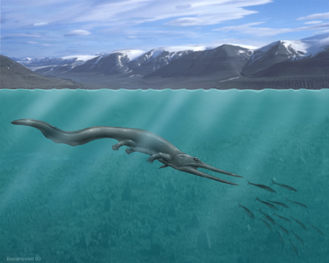 Reconstruction of Aphaneramma (by Bogdan Bocianowski)
Reconstruction of Aphaneramma (by Bogdan Bocianowski)
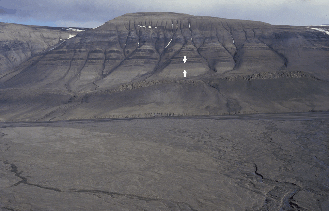 Wallenbergfjellet, on the eastern side of Fulmardalen, arrows indicating the position of the "Fish Niveau".
Wallenbergfjellet, on the eastern side of Fulmardalen, arrows indicating the position of the "Fish Niveau".
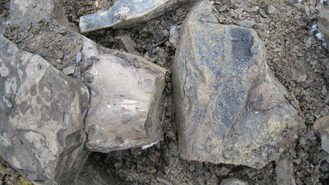 Concretion find in the "Fish Niveau" containing the partial skull of a specimen of Aphaneramma rostratum. The majority of vertebrate fossils is found in loose blocks. (Photo: Winand Brinkmann, 2008).
Concretion find in the "Fish Niveau" containing the partial skull of a specimen of Aphaneramma rostratum. The majority of vertebrate fossils is found in loose blocks. (Photo: Winand Brinkmann, 2008).
 In situ-concretion containing a specimen of the ammonite Arctoceras blomstrandi.
In situ-concretion containing a specimen of the ammonite Arctoceras blomstrandi.
 Naturally broken-up concretion containing a cranial impression (of a specimen) of the chondrostean Saurichthys.
Naturally broken-up concretion containing a cranial impression (of a specimen) of the chondrostean Saurichthys.
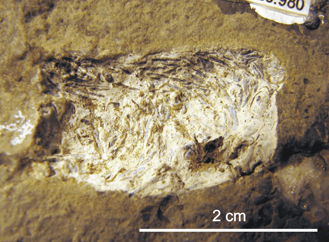 Coprolite with numerous inclusions of fish scales.
Coprolite with numerous inclusions of fish scales.
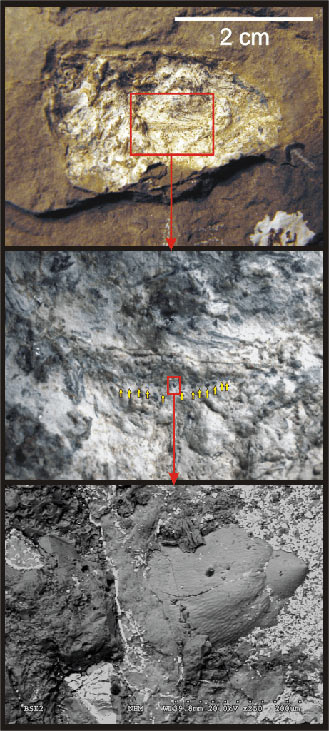 Coprolite containing a lower jaw ramus carrying minute denticles (third picture) in addition to usual teeth (arrows).
Coprolite containing a lower jaw ramus carrying minute denticles (third picture) in addition to usual teeth (arrows).
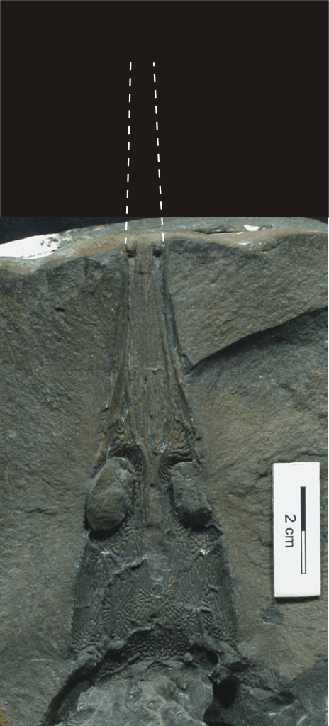 The holotype specimen of Aphaneramma rostratum (NRM B.1), rostral outlines (dashed) inferred from other specimens.
The holotype specimen of Aphaneramma rostratum (NRM B.1), rostral outlines (dashed) inferred from other specimens.
The Early Triassic deposits of Spitsbergen are well-known for their important vertebrate assemblages. Ichthyosaurs from two Spathian horizons belong to the earliest finds of their kind, while a 25 metres thick sequence from the Smithian stage yields a diverse fauna of chondrostean and coelacanthiform fishes and temnospondylian amphibians. The fishes formed the basis for a seminal two volume monograph by Erik Stensiö (1921, 1925). The temnospondyls gained fame for many years since they were then the only known amphibians from marine deposits. The sequence, designated as the "Fish Niveau" by Wiman (1910), constitutes the upper part of the Lusitaniadalen Member within the Vikinghøgda Formation of Mørk et al. (1999). The member is an equivalent to the Iskletten Member within the Sticky Keep Formation of Buchan et al. (1965).
Temnospondyls were the most diverse group of tetrapods in the late Palaeozoic, and probably the only non-amniote tetrapods that survived into the Mesozoic. The Spitsbergen forms are part of the radiation that followed a major decline during the end Permian crisis. Their morphology, taxonomy and ecology is the subject of ongoing studies at the Natural History Museum in Oslo, while the associated fish assemblage is currently being investigated by a co-operating team from Zürich.
All vertebrate remains are preserved in calcareous concretions. The majority of temnospondylian fossils are skull fragments, but also postcranial material is present. Associated are ammonites and bivalves, demonstrating the marine nature of the deposits. Among the eight species of temnospondyls recorded from the "Fish Niveau", the slender-snouted Aphaneramma rostratum is the most common. Growth series of this form show postnareal cranial lengths from 97 to 375 millimetres. Although a fairly complete(?) rostrum was found in 2008, the snout tip itself, and hence the total cranial length, is still unrecorded. Aphaneramma was definitely one of the most extremely long-snouted tetrapods ever.
A marine habitat is no longer a peculiarity of the Spitsbergen temnospondyls. Today, many assemblages are known (e.g. from Greenland, Sibiria, Kazakhstan, Spain, Madagascar, Pakistan, Australia), where one or several species are believed to have lived in a nearshore marine environment.
Impressive direct evidence for a marine habitat of Aphaneramma and the second common Spitsbergen genus Lyrocephaliscus, comes from the abundance of coprolites in the "Fish Niveau". These coprolites are always elongated, sometimes irregular and curved, but never spiral-shaped. Their length ranges from two to ten centimetres. Most of them contain numerous inclusions of fish scales, teeth, and even jaw, cranial or other bony fragments, indicating beyond doubt that the coprolites were produced by fish-eating vertebrates. Their size and shape exclude an origin from fishes. The apparent absence of other tetrapods from the "Fish Niveau" leaves the temnospondyls as the only possible source animals and makes the "Fish Niveau" coprolites one of the few Mesozoic examples whose origin is known, even down to species level. Quantity and size variation do not suggest that transport and sorting of any kind has taken place. The coprolites are therefore considered as evidence of in situ burial.
The facies change from the shales of the "Fish Niveau" to the dark grey shales of the following Member is said to reflect the shift towards a more distal, deeper and hypoxic depositional environment (Mørk et al. 1999). While the continuous occurrence of chondrosteans and coelacanths and the first appearance of ichthyosaurs show that conditions for vertebrate life persisted, the temnospondyls seem to disappear completely and suddenly. This may indicate that the shallow shelf area actually was their preferred habitat.
Buchan, S. H., Challinor, A., Harland, W. B. & Parker, J. R. 1965: The Triassic stratigraphy of Svalbard. Norsk Polarinstitutt Skrifter 135, 94 pp.
Mørk, A., Elvebakk, G., Forsberg, A. W., Hounslow, M. W., Nakrem, H. A., Vigran, J. O. & Weitschat, W. 1999: The type section of the Vikinghøgda Formation: a new Lower Triassic unit in central and eastern Svalbard. Polar Research 18 (1), 51-82.
Stensiö, E. A. 1921: Triassic fishes from Spitzbergen. Part I. Vienna, 307 pp.
Stensiö, E. A. 1925: Triassic fishes from Spitzbergen. Part II. Kungliga Svenska Vetenskapsakademiens Handlingar, Serie 3 (2), 1-261, 34 plts.
Wiman, C. 1910: Ichthyosaurier aus der Trias Spitzbergens. Bulletin of the Geological Institution of the University of Upsala X (3), 124-148, plts. V-X.